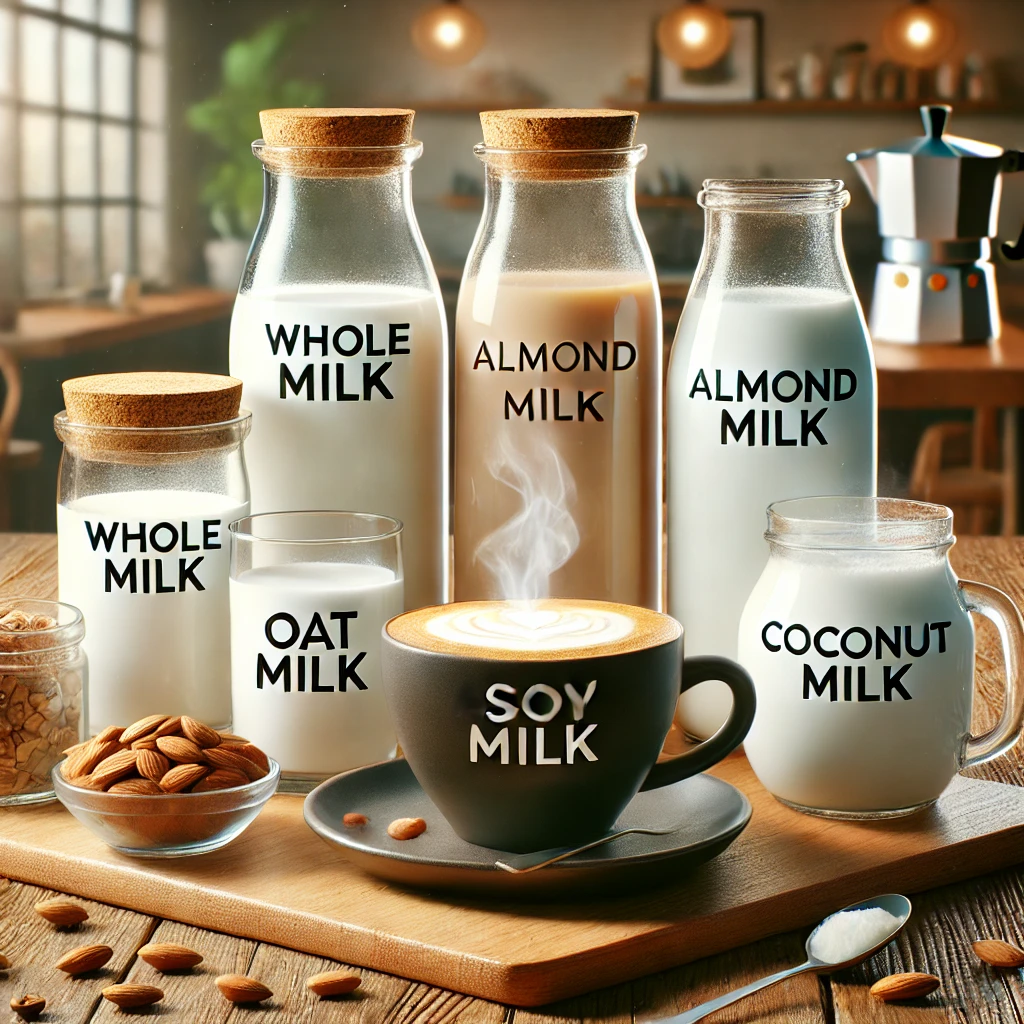Milk plays a crucial role in coffee, affecting its flavor, texture, and overall experience. Whether you enjoy a creamy latte, a rich cappuccino, or a dairy-free alternative, choosing the right milk can enhance your coffee in different ways.
In this guide, we’ll explore the best types of milk and non-dairy alternatives, their flavor profiles, and which ones work best for different coffee drinks.
1. How Milk Affects Coffee Flavor
Adding milk to coffee balances acidity, enhances sweetness, and creates a smoother texture. The key factors that influence how milk interacts with coffee include:
✔️ Fat content – Higher fat creates a creamier texture.
✔️ Protein content – Affects frothing and foam stability.
✔️ Sweetness – Some types of milk add natural sugars to coffee.
2. Best Dairy Milks for Coffee
| Milk Type | Flavor Profile | Foaming Ability | Best For |
|---|---|---|---|
| Whole Milk 🥛 | Creamy, rich, naturally sweet | Excellent | Lattes, cappuccinos, flat whites |
| 2% (Reduced Fat) Milk | Balanced, slightly lighter texture | Good | Lattes, mochas |
| Skim (Fat-Free) Milk | Light, slightly watery | Good, but less creamy | Cappuccinos, macchiatos |
| Half-and-Half (Cream + Milk) | Very rich and thick | Poor | Coffee creamers |
| Heavy Cream | Extremely thick and rich | Does not froth | Strong black coffee |
✅ Whole milk is the best option for creamy, rich coffee drinks.
✅ Skim milk creates light, airy foam, great for cappuccinos.
3. Best Non-Dairy Milk Alternatives for Coffee
Dairy-free milks have grown in popularity, but not all plant-based milks work well in coffee. Some curdle with acidity or separate when heated. Let’s explore the best options:
| Plant-Based Milk | Flavor Profile | Foaming Ability | Best For |
|---|---|---|---|
| Oat Milk 🌾 | Naturally sweet, creamy | Excellent | Lattes, cappuccinos |
| Almond Milk 🌰 | Nutty, slightly bitter | Good | Iced coffee, mochas |
| Soy Milk 🌱 | Neutral, slightly beany | Very good | Lattes, flat whites |
| Coconut Milk 🥥 | Sweet, tropical, rich | Medium | Iced coffee, macchiatos |
| Macadamia Milk 🌰 | Buttery, smooth | Good | Espresso drinks |
| Cashew Milk 🌰 | Mild, creamy | Poor | Cold brew |
| Rice Milk 🌾 | Sweet, watery | Poor | Black coffee |
4. Which Non-Dairy Milk Works Best for Frothing?
Frothing ability is crucial for lattes and cappuccinos. Here’s how different dairy-free options compare:
🔥 Best frothing options:
✔️ Oat milk – Thick, creamy, froths like dairy milk.
✔️ Soy milk – Stable foam, works well in espresso drinks.
✔️ Almond milk (barista version) – Good, but can separate if not formulated for coffee.
💡 Tip: Look for “barista edition” non-dairy milks, designed to froth well.
5. How to Prevent Plant-Based Milk from Curdling in Coffee
Some plant-based milks curdle when mixed with hot coffee, especially if the coffee is too acidic.
✔️ Use low-acid coffee beans (Brazilian, Sumatra).
✔️ Heat the milk before adding it to coffee.
✔️ Look for coffee-friendly versions of almond or soy milk.
6. Best Coffee Drinks for Different Milks
☕ Whole Milk → Lattes, cappuccinos, mochas
☕ Oat Milk → Flat whites, iced coffee, lattes
☕ Almond Milk → Iced lattes, cold brew, macchiatos
☕ Soy Milk → Hot lattes, espresso drinks
☕ Coconut Milk → Tropical-style iced coffee
Final Thoughts
The right milk or dairy-free alternative can transform your coffee. Whether you prefer the creaminess of whole milk, the smoothness of oat milk, or the nuttiness of almond milk, each option offers a unique taste and texture.
